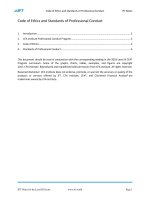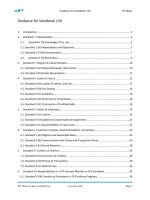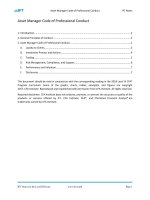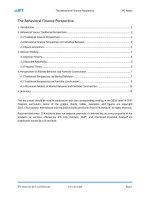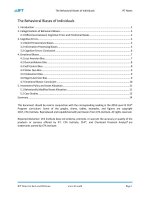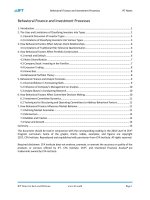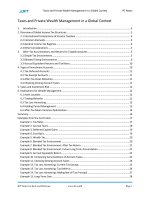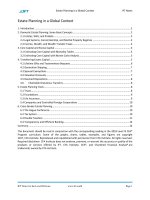CFA 2018 level 3 schweser practice exam CFA 2018 level 3 question bank 09 alternative investments answers
Bạn đang xem bản rút gọn của tài liệu. Xem và tải ngay bản đầy đủ của tài liệu tại đây (32.98 KB, 4 trang )
ALTERNATIVE INVESTMENTS
Answers
Question 1
Part A
Advantages:
1. Earlier and steadier cash flows.
2. Less frequent losses.
3. Less error in the measurement of returns.
4. The potential for using higher leverage.
Disadvantage: less upside potential than venture capital.
Sample Scoring Key:
1 point each for two advantages and one disadvantage.
Part B
Comment
"Private equity is more of a
diversifier than a long-term
return enhancer."
"There is also the carried
interest, which is interest
limited partners have to pay
to cover the financing costs
of leverage."
“You should use real estate
investments in raw land
rather than buyout funds to
generate more immediate
cash flow.”
“I want to make sure that the
preferred is structured so that
later investors can receive
seniority in order to increase
their claim on the company
assets.”
Is the
comment
correct?
(circle
one)
Yes
No
Yes
No
Yes
No
Yes
No
Explanation
The high correlation to equity reduces any portfolio
diversification benefit.
Carried interest is the share of the profits that is paid to the
manager.
Raw land generally provides no cash flow.
Buyout funds may generate income in excess of financing costs
and provide a more immediate cash flow to investors.
Subsequent rounds of convertible preferred are generally issued
senior to the earlier rounds, reducing the early investors’ claim on
company assets.
1
Sample Scoring Key:
1 point each for correctly identifying whether the comment is correct.
1 point for each explanation.
0 points if yes/no decision is incorrect.
Question 2
Part A
Backfill bias—managers who build a successful track record then begin to report results and the
past successful returns are then added to the index, biasing returns upward.
Survivorship bias—the past record of a fund that goes out of business is removed from the index.
These funds are more likely to have a poor record, biasing upward the reported return record.
Only the surviving funds are reported.
Sample Scoring Key:
1 point each for explaining each term and 2 points for explaining how and why it biases reported
returns upward.
Part B
i. Illiquidity leads to a lack of trading and the use of appraisal data for prices. Infrequent
appraisal data leads to less volatile prices and distorts downward reported standard deviation
used in the denominator of the Sharpe ratio, biasing the Sharpe ratio upward.
ii. A manager can increase reported return by compounding sub period return used in the
numerator of the Sharpe ratio while reducing the related reported standard deviation used in the
denominator by using multiplicative annualization. The combined result is to increase the
Sharpe ratio.
Sample Scoring Key:
3 points for each explanation. For full credit, the explanation must describe numerator and/or
denominator issues.
Question 3
Part A
Significant diversification: True. All three classes have low correlation to traditional stock and
bond portfolios, providing significant diversification.
2
Sufficient liquidity:
False. Real estate is not a regularly traded asset, and even if MWM does monthly valuation,
the underlying assets lack liquidity.
True. Commodity positions are generally taken with liquid derivative positions.
True. Managed futures typically use exchange traded derivative positions, and those are
liquid.
o (Alternative answer and explanation: False. Managed futures can be a subset of hedge
funds, and the manger may be using illiquid positions and strategies that cannot be
unwound.)
Sample Scoring Key:
One point each for: each asset class with a correct explanation of most likely true or false. There
are three asset classes and two features to discuss, for six points in total.
Candidate discussion: Explain implies you will receive no credit for only saying true or false.
Low correlation and liquidity of the underlying assets are the driving factors to the explanations.
Managed futures reflect manager skill and are not considered an asset class with inherent
characteristics. We don’t know the strategies used, allowing true or false for liquidity if properly
explained.
Part B
Manager strategy: Slide 3 indicates MWM is using commodities in a managed futures approach
of selectively taking long positions in backwardation markets and short positions in contango
markets to earn positive roll. She is not just long commodities to gain asset class exposure.
Sample Scoring Key:
One point for “manager strategy.” Three points for the explanation.
Candidate discussion: The key is that MWM targets value added in both downward
(backwardation) and upward-sloping (contango) markets. In other words, the manager takes long
and short positions. This is not long-only (commodity as an asset class) investing but a managed
futures strategy applied to the commodity market. Simply stating MWM takes both long and
short positions earns one of the three explanation points. That statement alone is weak (in a 4point question) when you had the information and training to elaborate. You should convey to the
grader how you know and support the decision. Describing the manager strategy to earn positive
roll return in both types of markets would be a convincing way to do so. You could mention the
slide states they are active cash managers but should not expect any credit. Simply being an
active manager is not the issue. The issue is that the slide indicates both long and short positions
are used, so there can be no inherent asset class characteristics. (In contrast, long-only positions
in commodity futures provide the inherent asset class characteristics of commodities.)
3
Part C
Advantages:
It represents investable securities.
It represents liquid investments.
It is not subject to appraisals and smoothing problems.
Disadvantages:
It reflects blended characteristics of RE and equity.
It reflects leveraged and over-stated return results.
Sample Scoring Key:
One point for each advantage listing two and one point for each disadvantage listing two. The
question is based on knowing how NAREIT and NCREIF indexes differ and match up with
evaluating a manager who purchases RE properties.
4
